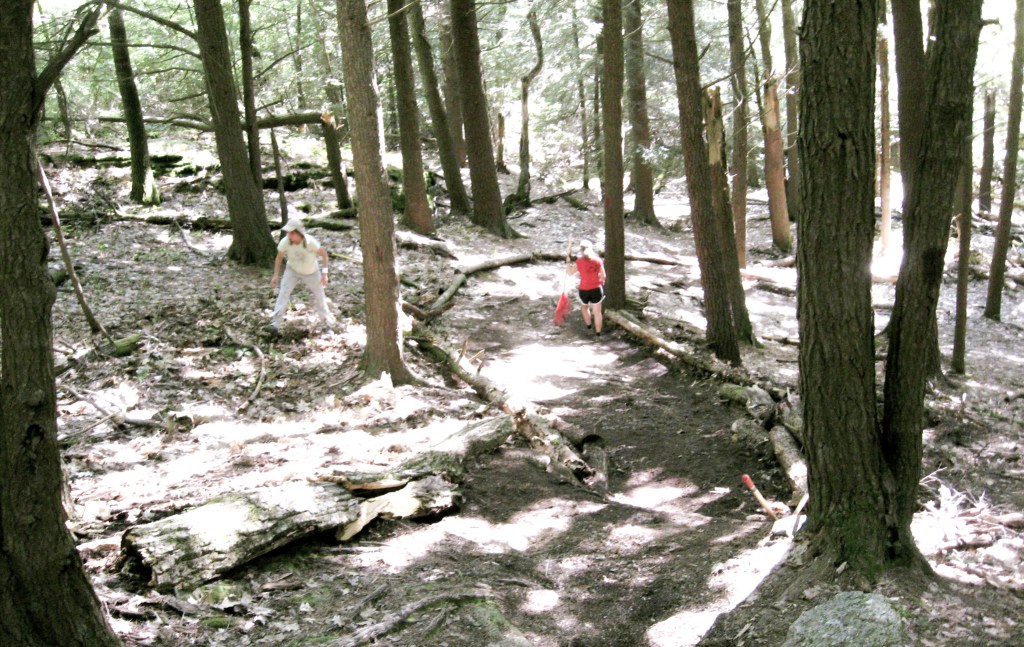Ian Parlin first tried trail running in junior high school, then quickly faked illness to escape cross-country practice. It wasn’t until years later, when Parlin volunteered at a trail race in Scotland while his wife competed, that he reconsidered. “I was captivated by the idea of a community coming together and supporting each other,” he says. “I was inspired to become part of the group.”
The couple soon moved to Portland, Maine, where Parlin found he quite enjoyed trail running. But there were no trail-running clubs, despite the state’s mountain bona fides: public lands that include Acadia National Park, White Mountain National Forest, the new Katahdin Woods and Waters National Monument, and 36 state parks including Baxter State Park, home to Mount Katahdin—the Appalachian Trail’s northern terminus. Parlin found that he had to cross state lines to compete in trail-running races.
So, in 2006, Parlin started Trail Monster Running, a free running club mainly for himself and his friends, and he started leading three group runs a week around Portland. As the Trail Monsters grew beyond his friends, he decided to keep it free. Instead of paying dues, aspiring Trail Monsters earn membership through trail work and volunteering at races.
This is not the standard model these days—most running clubs require an annual membership fee, somewhere in the $30 to $50 a year range, which covers things like operations and events. “Trails should be free and accessible, and so should our club,” Parlin says. “But if you want to wear the Trail Monsters shirt, you have to earn it. You have to show up so we know you’re committed to the sport and the community.”
Last year, the Trail Monsters debuted Maine’s first 100-mile race: Riverlands 100, staged at Androscoggin Riverlands State Park. This weekend, Parlin races Riverlands for the first time. As he races a 20-mile, out-and-back course with 1,800 feet of vertical gain on each lap, he’ll find Trail Monsters at three aid stations, all ready to support him to the finish.
“I’ve pushed myself in running to do things I never thought I was capable of. When I saw my friends and training partners going out and doing it, I realized what’s possible when we support each other,” says Parlin. “It’s beyond anything I ever thought of when I started the club.”

Members of Trail Monster Running do trail work to earn entry into the club. (Photo Credit: Trail Monster Running)
Parlin’s model is a throwback to trail running’s roots, when the modern version of the sport emerged as a fringe element of the 1970s jogging boom. “It was kind of a solo endeavor,” says Nancy Hobbs, who started trail running in the ’80s and founded the American Trail Running Association in 1996. “There wasn’t a social network; there wasn’t industry support.” Trail races and ultramarathons—those longer than a 26.2-mile marathon—were a grassroots effort; the first 100-mile runs followed routes for endurance horse-trail rides.
In the decades since, trail running has exploded. In 2007, the Outdoor Industry Association reports that some 4.2 million Americans participated in the sport; by 2016, that number hit 8.5 million. According to the RunUltra website, ultramarathons worldwide have increased 1,000 percent in the last 12 years, from 160 to 1,800.
What’s remained constant as the sport has grown is an expectation that trail runners give back to their community. As demand grew, several of the oldest 100-mile trail runs in the U.S. added service requirements, in addition to entry fees. Utah’s Wasatch Front 100 claims to be the first century race to require eight hours of trail work. Race director John Grobben says that requirement was added in the early 1990s. The event was filling up within two or three days, and organizers felt they could slow demand while supporting local and federal land managers.
“That failed miserably—we had just as many runners, if not more, wanting in with the trail work requirement,” says Grobben. Now, entries are awarded through a lottery system; everyone from elite athletes to overseas participants still complete trail work, resulting in 2,000 to 3,000 volunteer hours each year along the Wasatch Front. “It’s really cemented our relationship with all these government entities. They like to say, ‘You run in five miles, work eight hours, run out five miles and thank us for the privilege,’” Grobben says.

Participation in trail running has grown steadily in recent decades.
Since 1998, California’s 100-mile Western States racers have volunteered eight hours toward trail work or an organized running event in order to get a bib. The Vermont 100 requires the same, although they do offer a buyout option that benefits Vermont Adaptive Ski & Sports. “Volunteers are key to what we do,” says Amy Rusiecki, the Vermont 100’s race director. That event fields 500 participants and an equal number of volunteers. As terrain becomes more complex, volunteer numbers go up: Much of the Western States course can only be reached on foot, by horse or by helicopter. That means 369 racers rely on more than 1,500 volunteers at 21 aid stations.
The more actual runners among those ranks of volunteers, the better the race experience. “If you go to an aid station full of people who know ultras, they’ll grab your water bottle and fill it while you eat,” says Rusiecki. “They’ll say, ‘Hey, you look dehydrated. Here’s something salty to snack on.’ The community makes all the difference.”
At a time when budget and staff cuts leave a backlog of trail maintenance on public lands, clearing a downed tree or working to prevent erosion is a vital investment in the sport’s infrastructure.
“Trail runners often think we have little or no impact, but as our sport gets bigger, we do need to give back,” says Hobbs. “Whatever you can do to give back and support the trails you run is important, whether that’s dollars, expertise or a work day.”
